Numerical Investigation on the Urban Heat Island Effect by Using a Porous Media Model
Abstract
:1. Introduction
2. Model Descriptions and Methodology
2.1. Geometric Model
2.2. Mathematical Model
2.3. Boundary Conditions
2.4. Grid Independence Test and Computational Procedure
2.5. Model Verification
3. Results and Discussion
3.1. Characteristics of Macroscale Porous Flow
3.2. Influence of Different Parameters on the Urban Heat Island Effect
3.2.1. Influence of Ambient Crosswind Speed
3.2.2. Influence of Porosity in the Central Urban Area
3.2.3. Influence of Anthropogenic Heat in the Central Business District
4. Discussion
5. Conclusions
- The extent of the UHI effect is significantly affected by the ambient crosswind speed. An increase in the wind speed significantly reduces the UHI intensity, especially in the central area of a city. A 1 m/s increase in the wind speed reduces the UHI intensity by approximately 1.7–1.9 K.
- In concentric circle cities, an optimal porosity exists for the city central area that facilitates artificial heat dissipation. In this study, the optimal porosity value was about 0.6, and the heat dissipation performance was approximately the same for the porosity of 0.5 and 0.7.
- With anthropogenic heat source intensity increasing, the UHI intensity in the central business district is also increasing, with a maximum value of 4.5 K at the measured height of 10 m. The rate of increase in the UHI intensity in the central business district is influenced by the upstream area.
Author Contributions
Funding
Institutional Review Board Statement
Informed Consent Statement
Data Availability Statement
Conflicts of Interest
Nomenclature
| CF | Forchheimer coefficient |
| dp | Characteristic size of solid particles in porous media (m) |
| g | Gravitational acceleration (m∙s−2) |
| H | Height of urban canopy (m) |
| pf | Intrinsic average of the time-averaged pressure (Pa) |
| Q | Urban anthropogenic heat intensity(W·m−2) |
| Qb | Intensity of building heat source per unit area of ground surface (W·m−2) |
| q | Intensity of building heat source per unit volume of buildings (W·m−3) |
| Tin | Temperature at inlet (K) |
| ui | Wind speed components (m s−1) |
| uref | Reference velocity (m·s−1) |
| Vb | Volume of buildings per unit of ground surface (m3 m−2) |
| xi | Cartesian coordinates |
| z | Height (m) |
| zref | Reference height (m) |
| γ | The vertical temperature reduction rate (Km−1) |
| Fluid contained in the averaging volume (m3) | |
| Total volume of the averaging volume (m3) | |
| Porosity | |
| Intrinsic average of the time-averaged dissipation rate (m2 s−3) | |
| Constant | |
| Inlet mean dissipation rate at inlet (m2 s−3) | |
| μ | Dynamic viscosities (kg·m−1·s−2) |
| μt | Turbulent viscosities (kg·m−1·s−2) |
| Density (kg·m−3) | |
| Macro time-averaged quantities | |
| Intrinsic average variable | |
| Superficial average variable |
References
- Zhong, S.; Qian, Y.; Zhao, C.; Leung, R.; Yang, X.Q. A case study of urbanization impact on summer precipitation in the Greater Beijing Metropolitan Area: Urban heat island versus aerosol effects. J. Geophys. Res. Atmos. 2015, 120, 10,903–10,914. [Google Scholar] [CrossRef]
- Grimmond, S.C.; Oke, T.R. Aerodynamic properties of urban areas derived from analysis of surface form. J. Appl. Meteorol. 1999, 38, 1262. [Google Scholar] [CrossRef]
- Manley, G. On the Frequency of Snowfall in Metropolitan England. Q. J. R. Meteorol. Soc. 1958, 84, 70–72. [Google Scholar] [CrossRef]
- Mathew, A.; Khandelwal, S.; Kaul, N. Spatial and temporal variations of urban heat island effect and the effect of percentage impervious surface area and elevation on land surface temperature: Study of Chandigarh city, India. Sustain. Cities Soc. 2016, 26, 264–277. [Google Scholar] [CrossRef]
- Huang, L.; Li, J.; Zhao, D.; Zhu, J. A fieldwork study on the diurnal changes of urban microclimate in four types of ground cover and urban heat island of Nanjing, China. Build. Environ. 2008, 43, 7–17. [Google Scholar] [CrossRef]
- Sun, C.Y.; Kato, S.; Gou, Z. Application of Low-Cost Sensors for Urban Heat Island Assessment: A Case Study in Taiwan. Sustainability 2019, 11, 2759. [Google Scholar] [CrossRef] [Green Version]
- Sultana, S.; Satyanarayana, A. Urban heat island intensity during winter over metropolitan cities of India using remote-sensing techniques: Impact of urbanization. Int. J. Remote. Sens. 2018, 39, 6692–6730. [Google Scholar] [CrossRef]
- Singh, P.; Kikon, N.; Verma, P. Impact of land use change and urbanization on urban heat island in Lucknow city, Central India. A remote sensing based estimate. Sustain. Cities Soc. 2017, 32, 100–114. [Google Scholar] [CrossRef]
- Mirzaei, P.A.; Haghighat, F. Approaches to study Urban Heat Island–Abilities and limitations. Build. Environ. 2010, 45, 2192–2201. [Google Scholar] [CrossRef]
- Khan, S.M.; Simpson, R.W. Effect Of A Heat Island On The Meteorology Of A Complex Urban Airshed. Bound. Layer Meteorol. 2001, 100, 487–506. [Google Scholar] [CrossRef]
- Atkinson, B.W. Numerical Modelling of Urban Heat-Island Intensity. Bound. Layer Meteorol. 2003, 109, 285–310. [Google Scholar] [CrossRef]
- Takahashi, K.; Yoshida, H.; Tanaka, Y.; Aotake, N.; Wang, F. Measurement of thermal environment in Kyoto city and its prediction by CFD simulation. Energy Build. 2004, 36, 771–779. [Google Scholar] [CrossRef]
- Yushkov, V.P.; Kurbatova, M.M.; Varentsov, M.I.; Lezina, E.A.; Kallistratova, M.A. Modeling an Urban Heat Island during Extreme Frost in Moscow in January 2017. Izv. Atmos. Ocean. Phys. 2019, 55, 389–406. [Google Scholar] [CrossRef]
- Vitanova, L.L.; Kusaka, H. Study on the Urban Heat Island in Sofia City: Numerical Simulations with Potential Natural Vegetation and Present Land Use Data. Sustain. Cities Soc. 2018, 40, 110–125. [Google Scholar] [CrossRef]
- Jian, H.; Yuguo, L. Wind Conditions in Idealized Building Clusters: Macroscopic Simulations Using a Porous Turbulence Model. Bound. Layer Meteorol. 2010, 136, 129–159. [Google Scholar]
- Parker, J.C.; Lenhard, R.J.; Kuppusamy, T. A parametric model for constitutive properties governing multiphase flow in porous media. Water Resources Res. 1987, 23, 618–624. [Google Scholar] [CrossRef]
- Uth, M.F.; Jin, Y.; Kuznetsov, A.V.; Herwig, H. A direct numerical simulation study on the possibility of macroscopic turbulence in porous media: Effects of different solid matrix geometries, solid boundaries, and two porosity scales. Phys. Fluids 2016, 28, 70–77. [Google Scholar] [CrossRef]
- Jin, Y.; Uth, M.F.; Kuznetsov, A.; Herwig, H. Numerical investigation of the possibility of macroscopic turbulence in porous media: A direct numerical simulation study. J. Fluid Mech. 2015, 766, 76–103. [Google Scholar] [CrossRef]
- Nimvari, M.E.; Maerefat, M.; Jouybari, N.F.; El-Hossaini, M.K. Numerical simulation of turbulent reacting flow in porous media using two macroscopic turbulence models. Comput. Fluids 2013, 88, 232–240. [Google Scholar] [CrossRef]
- Getachew, D.; Minkowycz, W.J.; Lage, J.L. A Modified Form of the k–ε Model for Turbulent Flows of an Incompressible Fluid in Porous Media. Int. J. Heat Mass Transf. 2000, 43, 2909–2915. [Google Scholar] [CrossRef]
- Whitaker, S. The Forchheimer equation: A theoretical development. Transp. Porous Media 1996, 25, 27–61. [Google Scholar] [CrossRef]
- Antohe, B.V.; Lage, J.L. A general two-equation macroscopic turbulence model for incompressible flow in porous media-ScienceDirect. Int. J. Heat Mass Transf. 1997, 40, 3013–3024. [Google Scholar] [CrossRef]
- Brown, M.J. Comparison of Centerline Velocity Measurements Obtained around 2d and 3d Building Arrays in a Wind Tunnel. In Proceedings of the International Society of Environmental Hydraulics Conference, Tempe, AZ, USA, 5–8 December 2001. [Google Scholar]
- Lien, F.S.; Yee, E.; Cheng, Y. Simulation of mean flow and turbulence over a 2D building array using high-resolution CFD and a distributed drag force approach. J. Wind. Eng. Ind. Aerodyn. 2004, 92, 117–158. [Google Scholar] [CrossRef]
- Hu, Z.; Yu, B.; Chen, Z.; Li, T.; Min, L. Numerical investigation on the urban heat island in an entire city with an urban porous media model. Atmos. Environ. 2012, 47, 509–518. [Google Scholar] [CrossRef]
- Jian, H.; Li, Y. Macroscopic simulations of turbulent flows through high-rise building arrays using a porous turbulence model. Build. Environ. 2012, 49, 41–54. [Google Scholar]
- Wang, X.; Li, Y.; Hang, J. A combined fully-resolved and porous approach for building cluster wind flows. Build. Simul. 2017, 10, 97–109. [Google Scholar] [CrossRef]
- Wang, X.; Li, Y. Predicting urban heat island circulation using CFD. Build. Environ. 2016, 99, 82–97. [Google Scholar] [CrossRef]
- Chen, G.; Yang, X.; Yang, H.; Hang, J.; Lin, Y.; Wang, X.; Liu, Y. Integrated impacts of tree planting and street aspect ratios on CO dispersion and personal exposure in full-scale street canyons. Build. Environ. 2019, 169, 106529. [Google Scholar]
- Fan, Y.; Hunt, J.; Li, Y. Buoyancy and turbulence-driven atmospheric circulation over urban areas. J. Environ. Sci. 2017, 59, 63–71. [Google Scholar] [CrossRef]
- Chen, G.; Yang, X.; Yang, H.; Hang, J.; Lin, Y.; Wang, X.; Liu, Y. The influence of aspect ratios and solar heating on flow and ventilation in 2D street canyons by scaled outdoor experiments-ScienceDirect. Build. Environ. 2020, 185, 107159. [Google Scholar] [CrossRef]
- Chen, G.; Wang, D.; Wang, Q.; Li, Y.; Wang, K. Scaled outdoor experimental studies of urban thermal environment in street canyon models with various aspect ratios and thermal storage. Sci. Total. Environ. 2020, 726, 138147. [Google Scholar] [CrossRef]
- Gu, Z.L.; Zhang, Y.W. Large eddy simulation methods and application for building and urban wind environment simulation. Beijing Sci. Press. 2014, 64, 47–81. [Google Scholar]
- Burgess, E.W. The Growth of the City: An Introduction to a Research Project; University of Chicago Press: Chicago, IL, USA, 2008. [Google Scholar]
- Fernando, H.J.S. Fluid Dynamics of Urban Atmospheres in Complex Terrain. Annu. Rev. Fluid Mech. 2010, 42, 365–389. [Google Scholar] [CrossRef]
- Ritter, B.R.E.; Hanna, S.R. Flow and dispersion in urban areas. Annu. Rev. Fluid Mech. 2003, 35, 469–496. [Google Scholar] [CrossRef]
- Zuev, V.E.; Kas’Yanov, E.I.; Titov, G.A. Radiative characteristics of the system ‘broken cloudiness-underlying surface’. In Proceedings of the SPIE-The International Society for Optical Engineering, San Diego, CA, USA, 12–14 July 1993. [Google Scholar]
- Martínez-Chico, M.; Batlles, F.J.; Bosch, J.L. Cloud classification in a mediterranean location using radiation data and sky images-ScienceDirect. Energy 2011, 36, 4055–4062. [Google Scholar] [CrossRef]
- Zhang, N.; Wang, X.; Peng, Z. Large-Eddy Simulation of Mesoscale Circulations Forced by Inhomogeneous Urban Heat Island. Bound. Layer Meteorol. 2014, 151, 179–194. [Google Scholar] [CrossRef]
- Rajapaksha, I.; Nagai, H.; Okumiya, M. A ventilated courtyard as a passive cooling strategy in the warm humid tropics. Renew. Energy 2003, 28, 1755–1778. [Google Scholar] [CrossRef]
- Leung, K.K.; Liu, C.H.; Wong, C.; Lo, J.; Ng, G. On the study of ventilation and pollutant removal over idealized two-dimensional urban street canyons. Build. Simul. 2012, 5, 359–369. [Google Scholar] [CrossRef]
- Wang, H.; Peng, C.; Li, W.; Ding, C.; Zhou, N. Porous media: A faster numerical simulation method applicable to real urban communities. Urban Climate. 2021, 38, 100865. [Google Scholar] [CrossRef]
- Memon, R.A.; Leung, D.; Liu, C. A review on the generation, determination and mitigation of Urban Heat Island. J. Environ. Sci. 2008, 20, 120–128. [Google Scholar]
- He, B.J.; Ding, L.; Prasad, D.K. Urban ventilation and its potential for local warming mitigation: A field experiment in an open low-rise gridiron precinct. Sustain. Cities Soc. 2020, 55, 102028. [Google Scholar] [CrossRef]
- Morris, C.; Simmonds, I.; Plummer, N. Quantification of the Influences of Wind and Cloud on the Nocturnal Urban Heat Island of a Large City. J. Appl. Meteorol. 1992, 40, 169–182. [Google Scholar] [CrossRef]
- Schlünzen, K.; Hoffmann, P.; Rosenhagen, G.; Riecke, W. Long-term changes and regional differences in temperature and precipitation in the metropolitan area of Hamburg. Int. J. Climatol. 2010, 30, 1121–1136. [Google Scholar] [CrossRef]
- Memon, R.A.; Leung, D. Impacts of environmental factors on urban heating. J. Environ. Sci. 2010, 12, 1903–1909. [Google Scholar] [CrossRef]
- Kikegawa, Y.; Genchi, Y.; Yoshikado, H.; Kondo, H. Development of a numerical simulation system toward comprehensive assessments of urban warming countermeasures including their impacts upon the urban buildings’ energy-demands. Appl. Energy 2003, 76, 449–466. [Google Scholar] [CrossRef]
- Kato, S.; Yamaguchi, Y. Analysis of urban heat-island effect using ASTER and ETM+ Data: Separation of anthropogenic heat discharge and natural heat radiation from sensible heat flux. Remote. Sens. Environ. 2005, 99, 44–54. [Google Scholar] [CrossRef]
- Offerle, B.; Grimmond, C.; Fortuniak, K. Heat storage and anthropogenic heat flux in relation to the energy balance of a central European city centre. Int. J. Climatol. 2005, 25, 1405–1419. [Google Scholar] [CrossRef]
- Ichinose, T.; Shimodozono, K.; Hanaki, K. Impact of anthropogenic heat on urban climate in Tokyo. Atmos. Environ. 1999, 33, 3897–3909. [Google Scholar] [CrossRef]
- Du, H.; Wang, D.; Wang, Y.; Zhao, X.; Fei, Q.; Hong, J.; Cai, Y. Influences of land cover types, meteorological conditions, anthropogenic heat and urban area on surface urban heat island in the Yangtze River Delta Urban Agglomeration. Sci. Total. Environ. 2016, 571, 461–470. [Google Scholar] [CrossRef] [PubMed]
- Bhuian, M.H.; Dewan, A.; Mahmud, G.I.; Hassan, Q.K.; Kiselev, G. Surface urban heat island intensity in five major cities of Bangladesh: Patterns, drivers and trends. Sustain. Cities Soc. 2021, 71, 102926. [Google Scholar]
- Yao, R.; Wang, L.; Huang, X.; Liu, Y.; Wang, L. Long-term trends of surface and canopy layer urban heat island intensity in 272 cities in the mainland of China. Sci. Total. Environ. 2021, 772, 145607. [Google Scholar] [CrossRef] [PubMed]
- Guo, A.D.; Yang, J.; Xiao, X.M.; Xia, J.H.; Jin, C.; Li, X.M. Influences of urban spatial form on urban heat island effects at the community level in China. Sustain. Cities Soc. 2019, 53, 101972. [Google Scholar] [CrossRef]
- Oke, T.R. Canyon geometry and the nocturnal urban heat island: Comparison of scale model and field observations. Int. J. Climatol. 2010, 1, 237–254. [Google Scholar] [CrossRef]




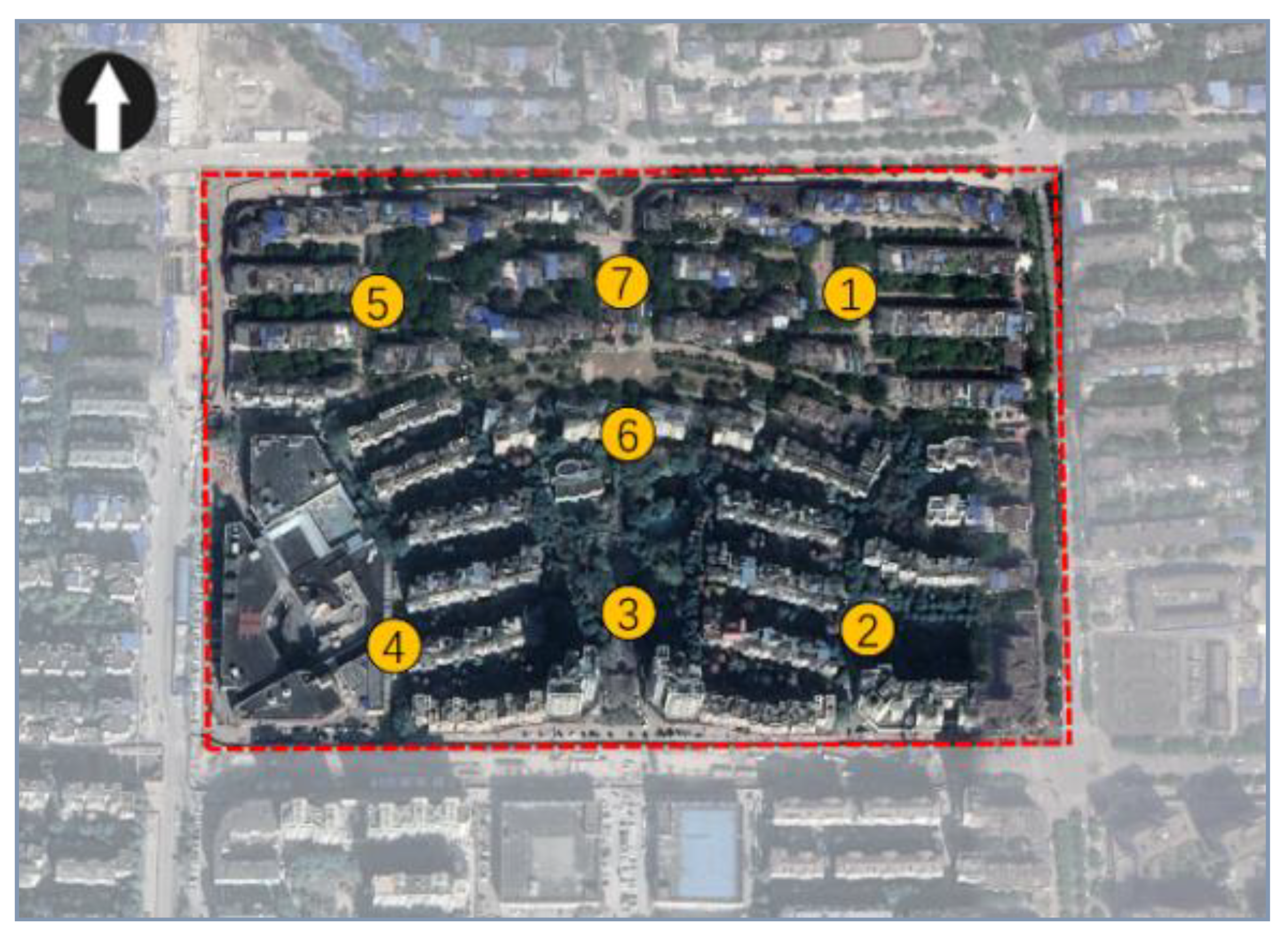

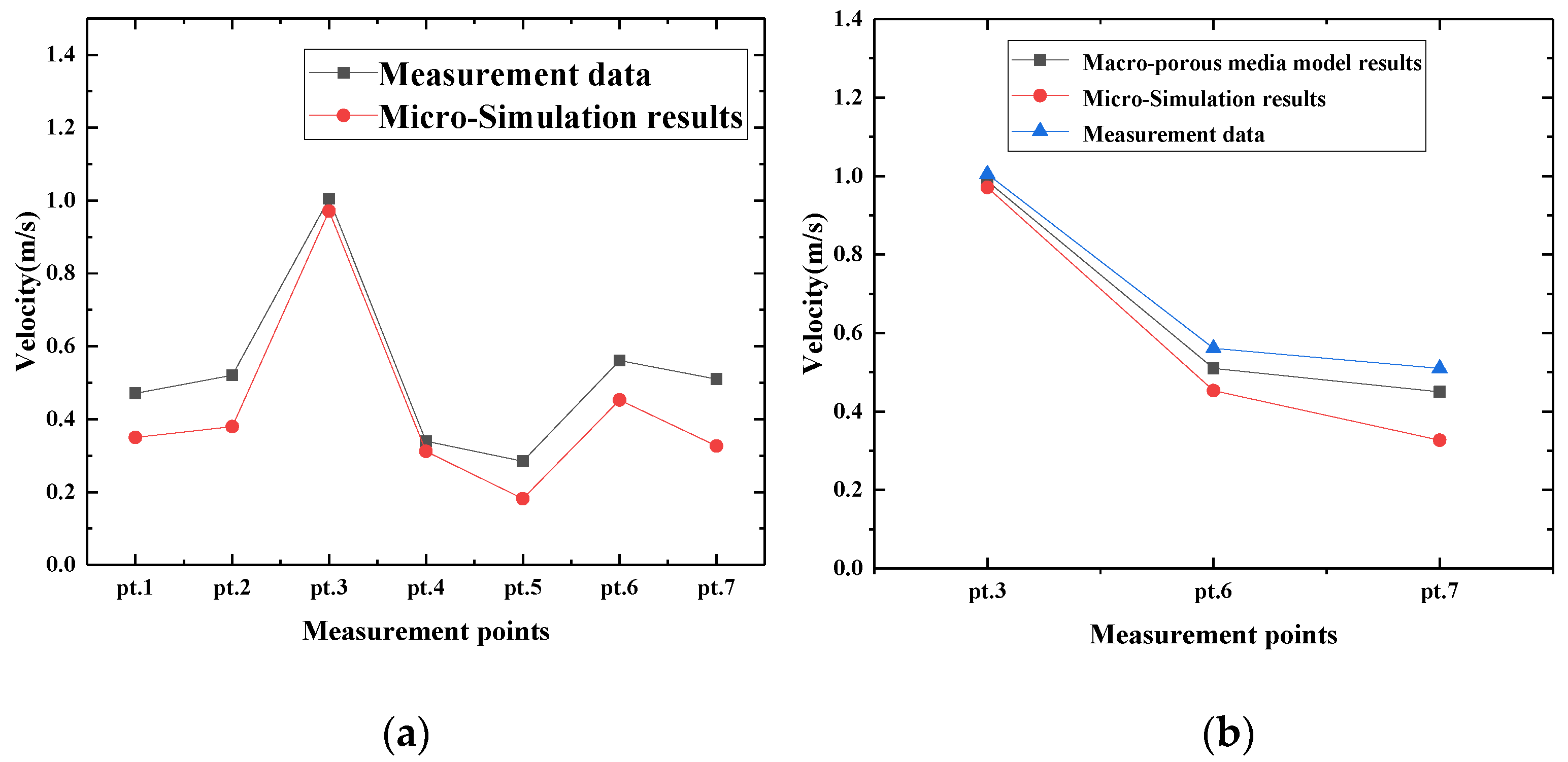
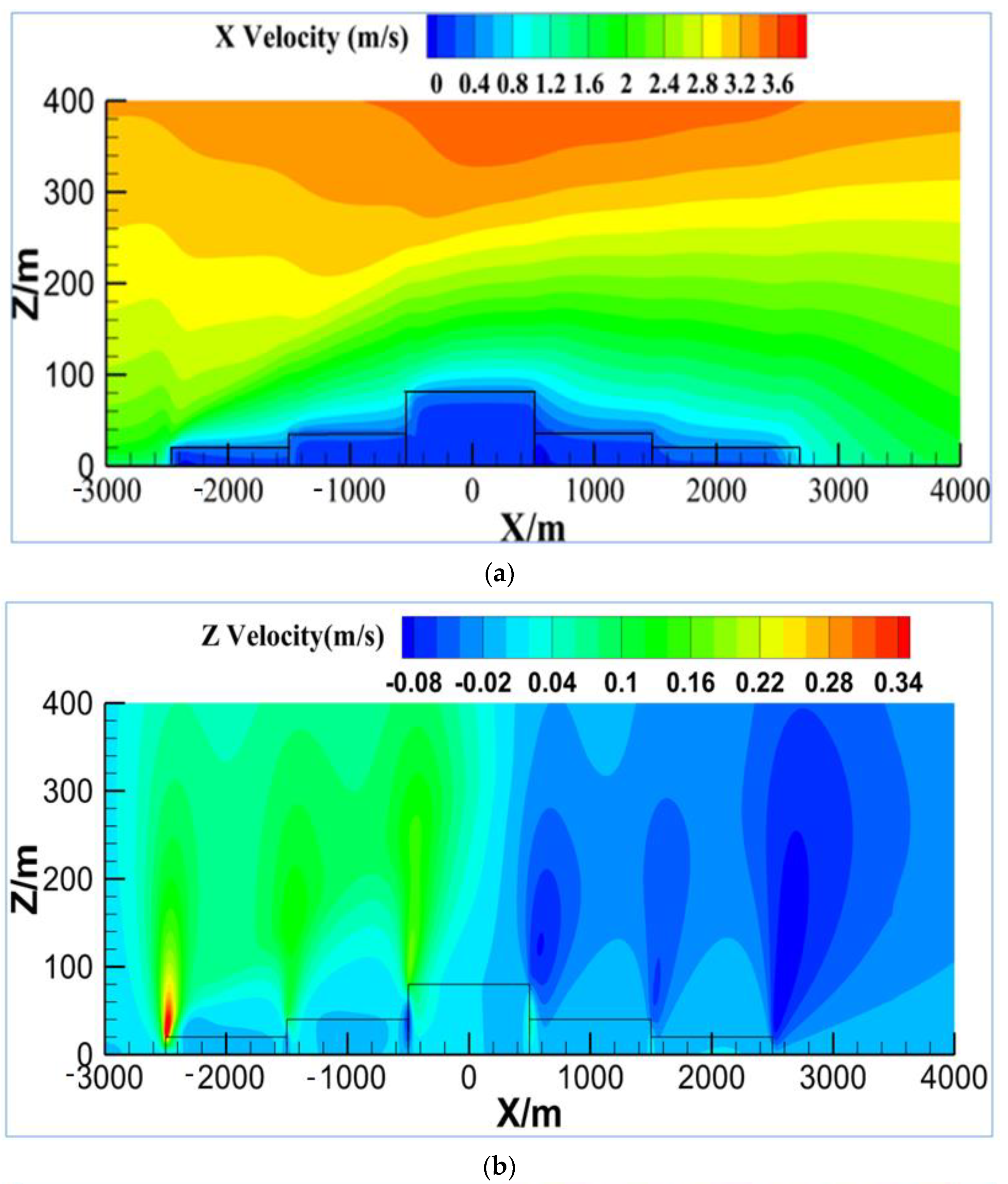
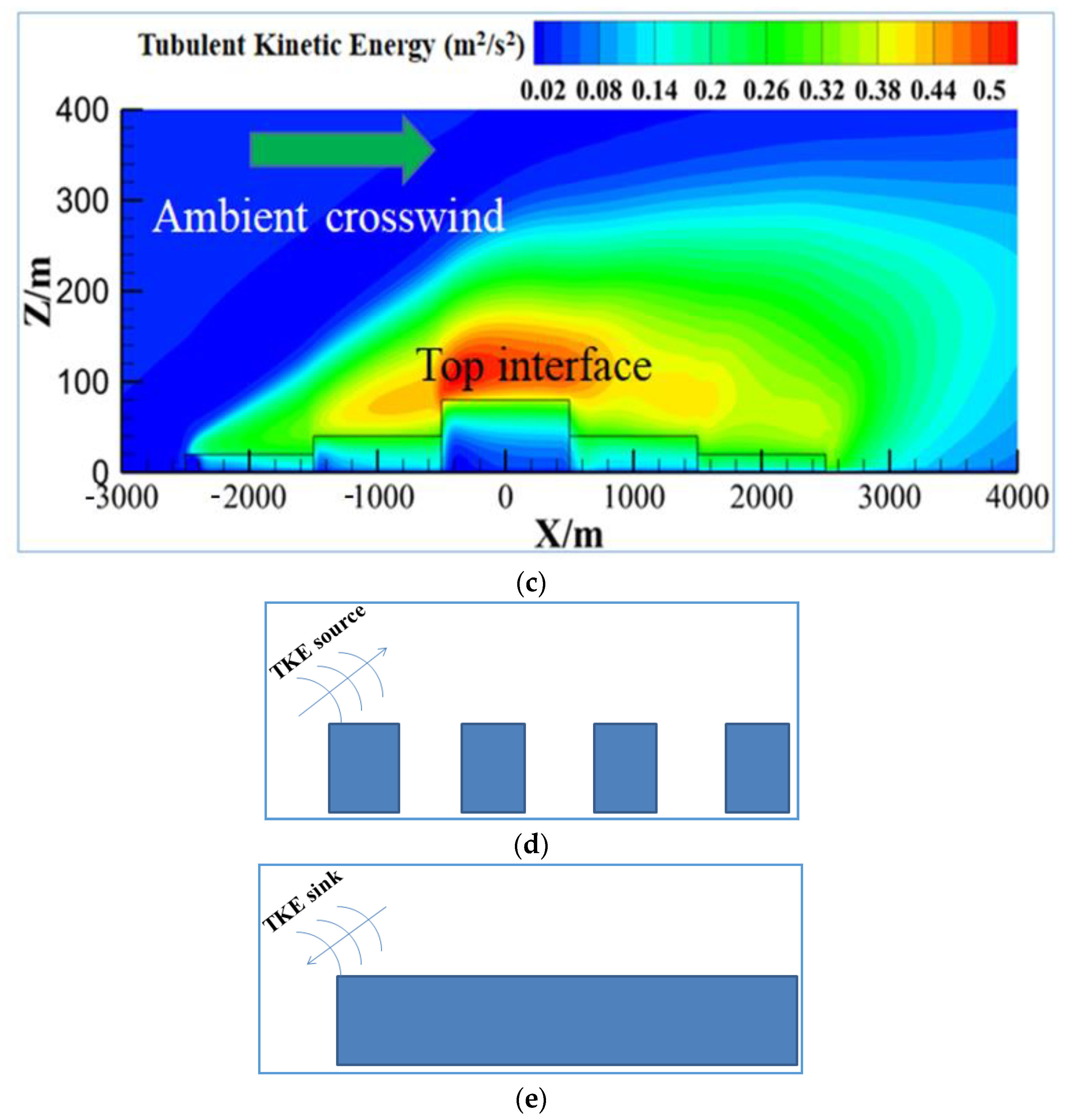
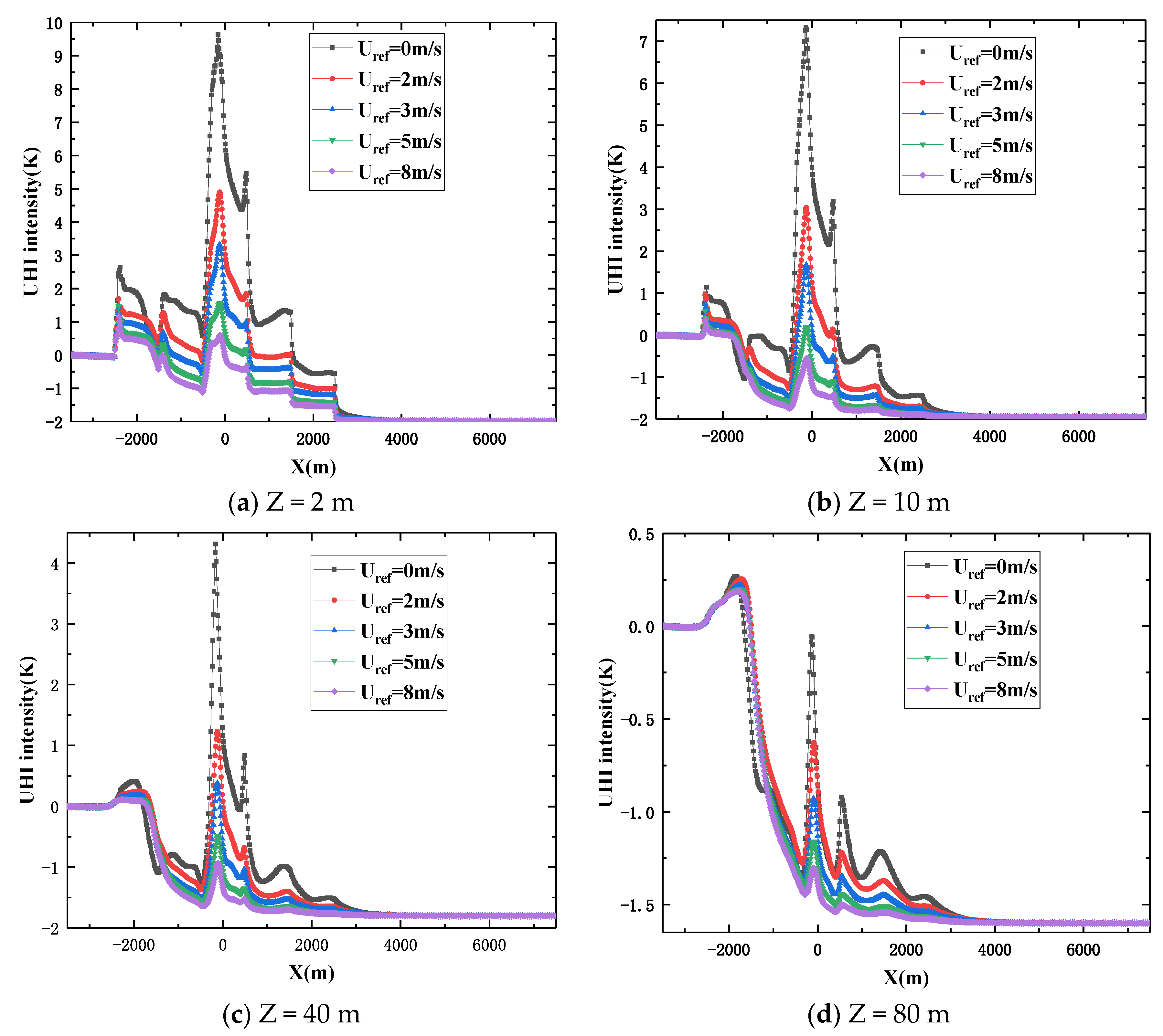
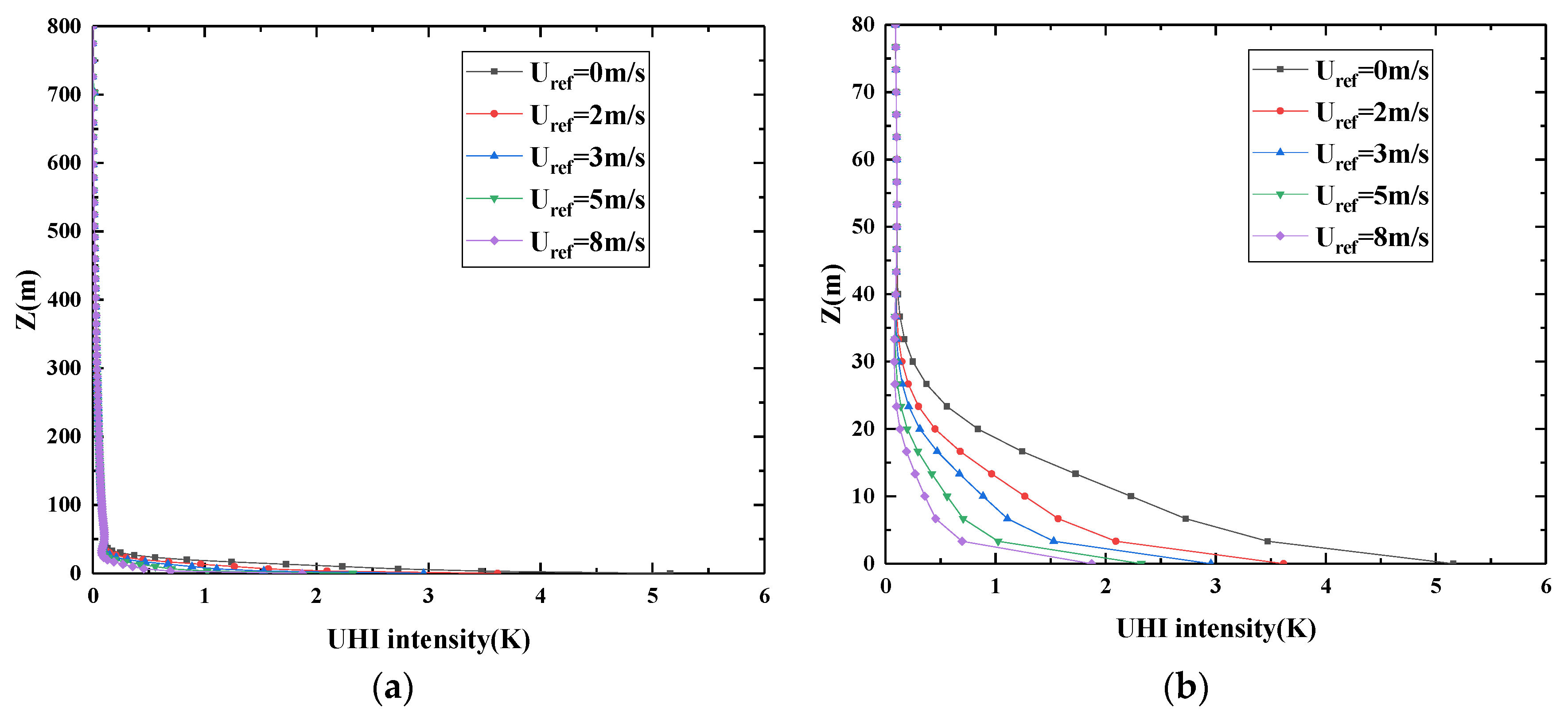
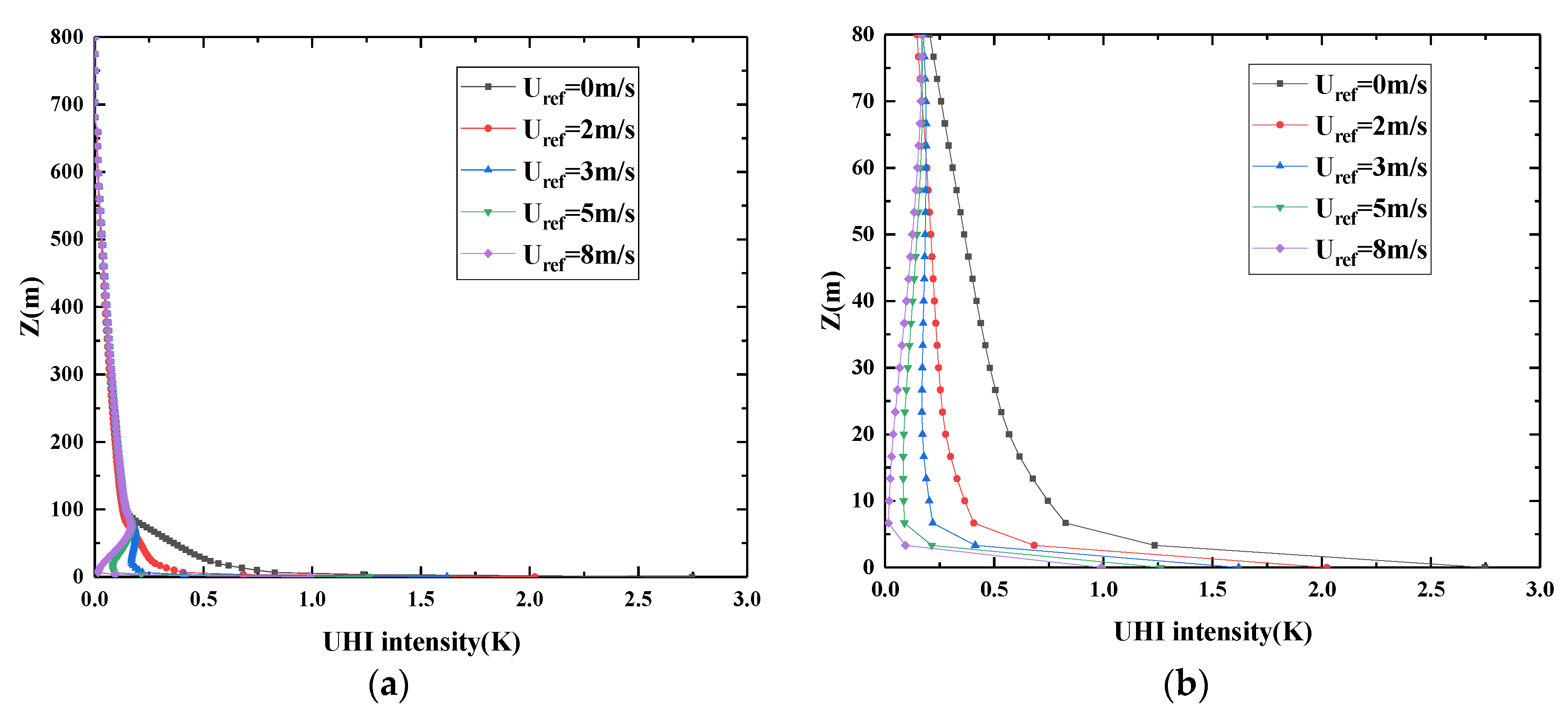
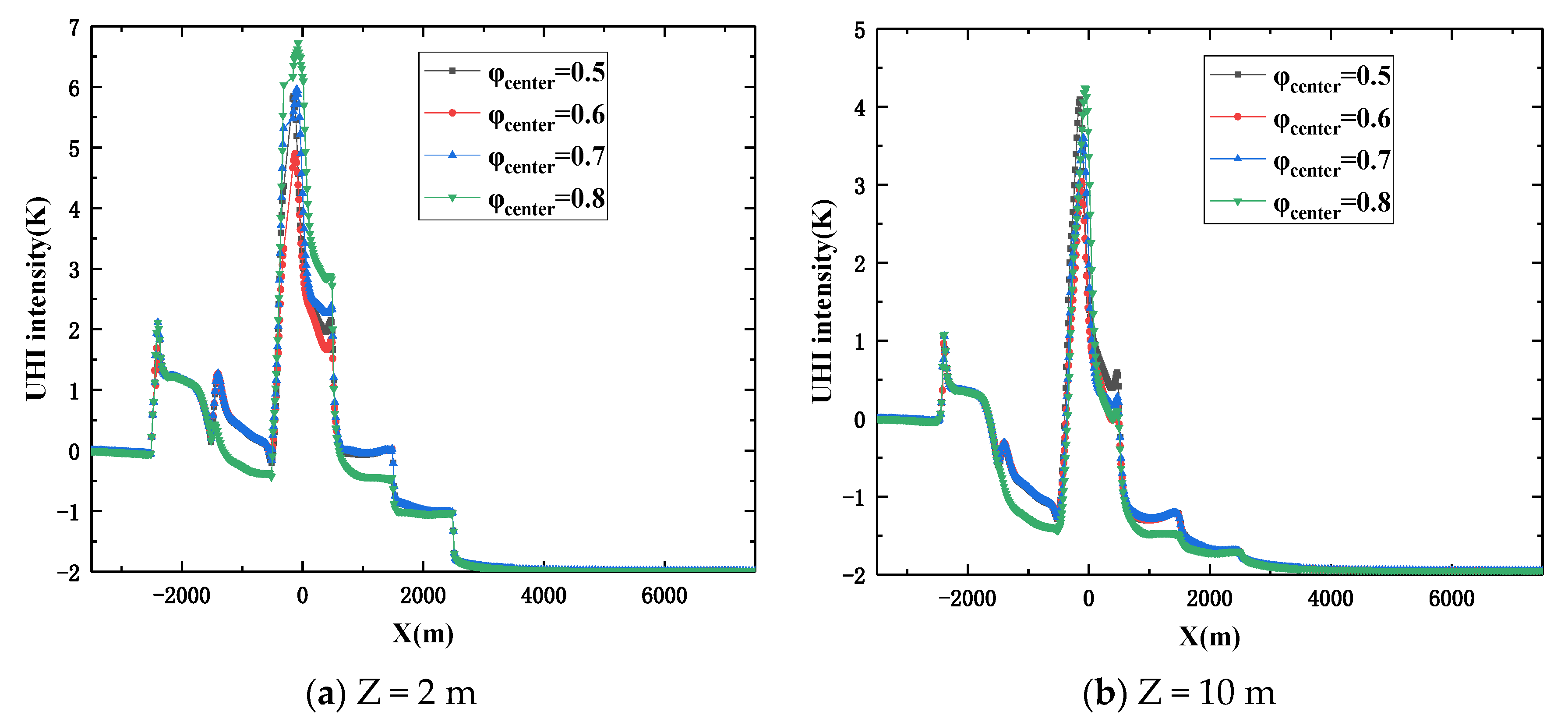


| Surfaces | Standard Method | Porous Method. |
|---|---|---|
| Inlet | Velocity-inlet | Velocity-inlet |
| Sides and Top | Symmetry | Symmetry |
| Underlying surface | No-Slipping Wall | No-Slipping Wall |
| Outlet Porous zone | Outflow | Outflow Interior |
Publisher’s Note: MDPI stays neutral with regard to jurisdictional claims in published maps and institutional affiliations. |
© 2021 by the authors. Licensee MDPI, Basel, Switzerland. This article is an open access article distributed under the terms and conditions of the Creative Commons Attribution (CC BY) license (https://creativecommons.org/licenses/by/4.0/).
Share and Cite
Ming, T.; Lian, S.; Wu, Y.; Shi, T.; Peng, C.; Fang, Y.; de Richter, R.; Wong, N.H. Numerical Investigation on the Urban Heat Island Effect by Using a Porous Media Model. Energies 2021, 14, 4681. https://doi.org/10.3390/en14154681
Ming T, Lian S, Wu Y, Shi T, Peng C, Fang Y, de Richter R, Wong NH. Numerical Investigation on the Urban Heat Island Effect by Using a Porous Media Model. Energies. 2021; 14(15):4681. https://doi.org/10.3390/en14154681
Chicago/Turabian StyleMing, Tingzhen, Shengnan Lian, Yongjia Wu, Tianhao Shi, Chong Peng, Yueping Fang, Renaud de Richter, and Nyuk Hien Wong. 2021. "Numerical Investigation on the Urban Heat Island Effect by Using a Porous Media Model" Energies 14, no. 15: 4681. https://doi.org/10.3390/en14154681
APA StyleMing, T., Lian, S., Wu, Y., Shi, T., Peng, C., Fang, Y., de Richter, R., & Wong, N. H. (2021). Numerical Investigation on the Urban Heat Island Effect by Using a Porous Media Model. Energies, 14(15), 4681. https://doi.org/10.3390/en14154681









